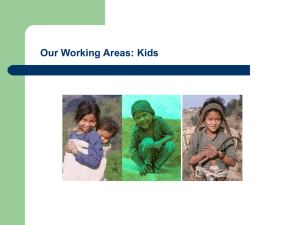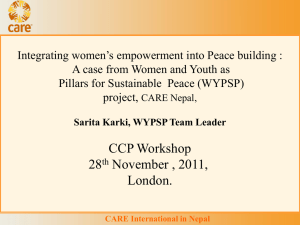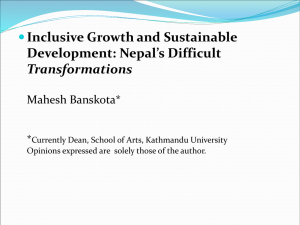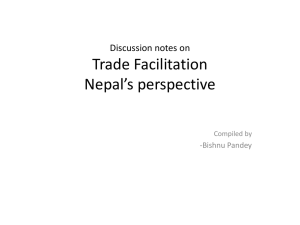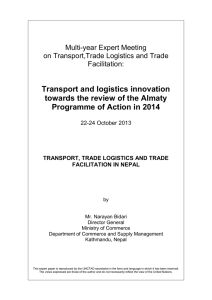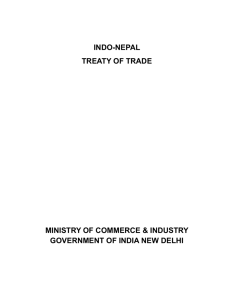Trade Facilitation: A Nepalese Perspective
advertisement
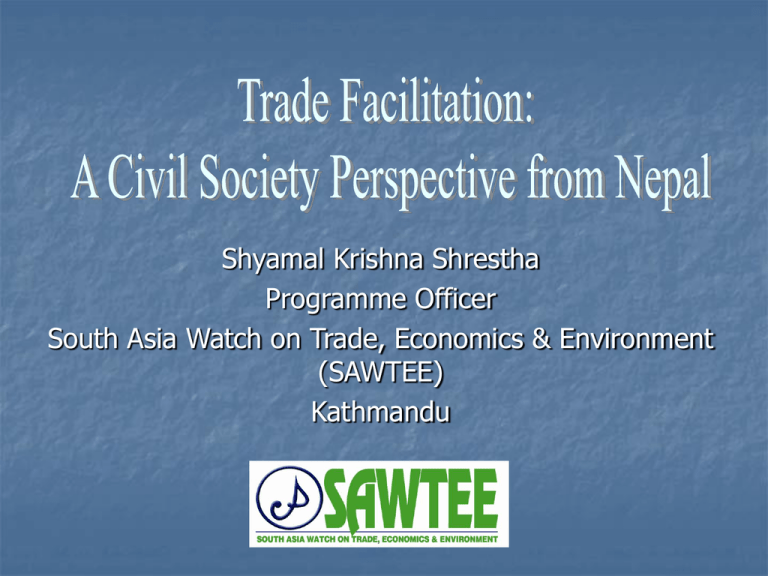
Shyamal Krishna Shrestha Programme Officer South Asia Watch on Trade, Economics & Environment (SAWTEE) Kathmandu 1. Objectives To provide a background on trade facilitation (TF) as part of a ‘single undertaking’ under the ongoing Doha Round trade negotiations, launched in 2001 To present Nepal’s situation on TF from a civil society perspective To examine current debates on TF based on studies by international organizations such as World Trade Organization (WTO), The World Bank and Organisation for Economic Co-operation and Development (OECD) To identify main challenges with respect to TF 2. Background WTO defines TF as: “the simplification and harmonization of international trade procedures”, whereas trade procedures are the “activities, practices and formalities involved in collecting, presenting, communication and processing data required for the movement of goods in international trade” The Doha Declaration (paragraph 27) limits the TF agenda to GATT 1994 Articles V (freedom of transit), VIII (fees and formalities connected with importation and exportation) and X (publication and administration of trade regulations) 2. Background (contd.) TF negotiations aim to simplify customs procedures and cut commerce-related red tape, as well as to enhance developing countries' ability to participate in international goods trade. The July 2004 Framework – in Annex D – specified that developing countries and LDCs would not have to implement future TF obligations unless they received the technical assistance necessary to do so Negotiating Group on Trade Facilitation (NGTF) formed on 12 October 2004. It has met several times to further improve and clarify Articles V, VIII and X Some progress reported despite North-South divisions 3. Nepal 1. Nepal became the 147th member of the WTO on 23 April 2004. It is the first LDC to join the WTO through the full working party negotiation process 2. Trade profile: GNP per capita Trade per capita 04) GDP to trade ratio Share in world total exports (both merchandise & services) Share in world total imports (both merchandise & services) US$ 260 (2005) US$ 122 (200250% 0.03 (2004) 0.04 (2004) 3.1 Article V Nepal, being a landlocked country, requires transit facilities from India for trading with the rest of the world The treaties of trade and transit between India and Nepal govern the rules and regulations pertaining to transit (barring the ‘economic blockade’ episode during 1988-90) Department of Customs collects for more than 50% of Nepal’s total tax revenue Transit facilities disrupted occasionally due to domestic political instability such as bandhs and strikes over the past few years 3.2 Article VIII Fees and levies charged are large in number, undertaken by individual industry associations. Customs clearance requires filling 83 documents with 102 copies and 113 signatures, totaling 22 days. UNCTAD supported ASYCUDA (Automated Systems for Customs Data) and ACIS (Advanced Cargo Information System) for reducing documentation requirements in Bhairawa, Birgunj, Kathmandu and Biratnagar, covering 90% of Nepal’s trade Single Administrative Document (SAD) introduced under ASYCUDA Customs reforms on the anvil, dealing with governance, institutions and infrastructure. Nepal has committed in its Working Party Report to comply with international standards on documentation procedures by 2007. 3.3 Article X Nepal publishes all trade-related measures and laws, regulations in which it is a party in the Nepal gazette. Plans to introduce an official website. No known mechanisms for advance rulings, no single enquiry points and consultative mechanism Appeals can be made to the Ministry of Industry, Commerce and Supplies, within 35 days 3.4 Nepal’s situation Trade transaction costs (TTC) remain high despite unilateral, bilateral, regional and multilateral liberalization Characterized by poor physical infrastructure, high transport and communication costs, inefficient customs and administrative delays at borders and ports, and inefficient payments system The ratio of the total length of all roadways to area in Nepal is 0.11 km per sq. km. Poor programme implementation, lack of coordination among and between countries, inadequate skilled manpower and lack of a multisectoral approach to TF Country is not able to export major products, including perishable goods, due to procedural delays 4. Overall South Asian scenario Chart 1 shows that companies in mostly developing countries perceive border procedures as a serious impediment to growth. Two-thirds of companies in South Asia perceived customs and foreign trade regulations to be a major or moderate obstacle for their business As small and medium enterprises create most new jobs in low-income countries, surveys show that they are more negatively affected by inefficient customs procedures than are multinational enterprises India plans to build 13 trade centres along its borders at a cost of US$ 185 million to boost commerce with its South Asian neighbours. Eight will be developed along India’s border with Bangladesh, four along the border with Nepal, and one with Pakistan 5. Economic impact of TF (see OECD, 2005) On trade flows: positive link between trade facilitation and trade, significantly increased trade for even modest reductions in TTC, esp. for developing countries Improved customs procedures – especially in ports – increase trade flows, All trading countries stand to gain, viz., exporters and importers Underscores the need for unilateral action 5. Economic impact of TF (contd.) On government revenue: Raising efficiency of weak customs administration has a positive impact on revenue collection Curbs smuggling, narrows the gap between ‘actual’ and ‘potential’ revenue On FDI: Insertion into global production networks rely on timely delivery of imports and exports Efficient TF reduces hassles and red-tape and determines investment decisions 6. Challenges Technical assistance and capacity building required, especially for LDCs Required from developed WTO Members and international agencies under ‘aid for trade’ package Bilateral and regional cooperation is also necessary Individual countries must also address supply side bottlenecks and allocate resources in an optimal manner for development priorities 7. References Thennakoon, J; and D. Weerakoon. 2006. Trade Facilitation in South Asia: Doha Round and Beyond. Briefing Paper. No. 2. Kathmandu: SAWTEE Engman, M. 2005. The Economic Impact of Trade Facilitation. Trade Policy Working Paper 21. Paris: OECD (http://www.oecd.org/trade) His Majesty’s Government of Nepal. 2004. Nepal: Trade and Competitiveness Study. Kathmandu: Ministry of Industry, Commerce and Supplies Wikramasinghe, U. 2004. A Multilateral Approach to Trade Facilitation in South Asia. Discussion Paper. Kathmandu: SAWTEE World Trade Organization (WTO) THANK YOU!


